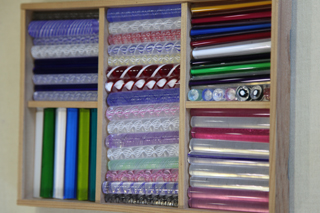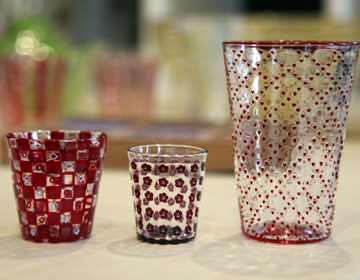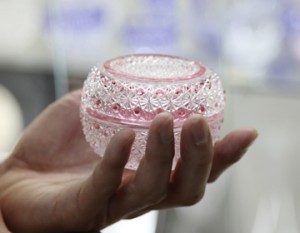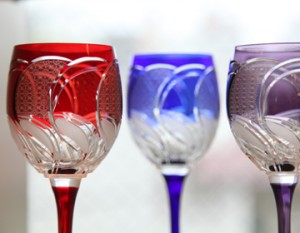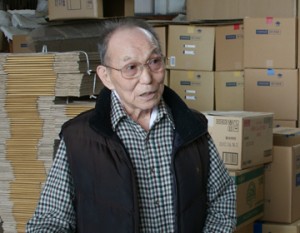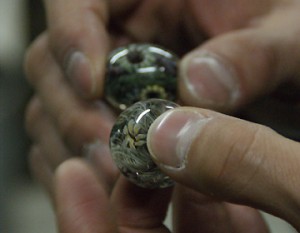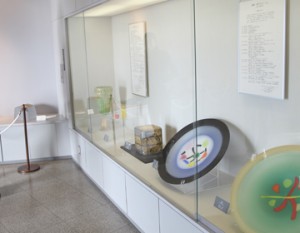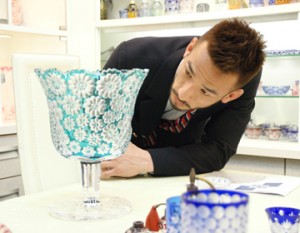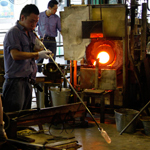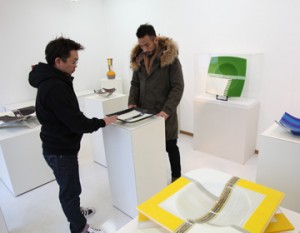Making pieces with murrini technique
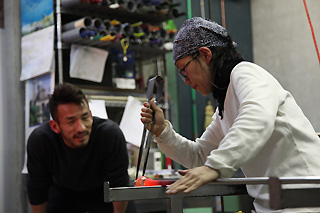
When we visited ”Glass Studio Silica” in Ibaraki, Fujiko Enami was coincidentally invited as the guest artist. We heard that she had a studio in Kanagawa where she worked with another glasswork artist, Ushio Konishi, prompting this interview.
At the studio, we asked about her work. Enami is particularly good at a technique called ”murrini” which is often used in making Venetian glass. First, a bundle of glass rods of various colors are molted and bound together to make a ”cane.” The cane is cut into many small pieces of ”Kintaro Candy.” This becomes the basic material for her work. The little pieces are put together in order to create the pattern of her image, first baked in a kiln, then blown into shape and then the adjusted.
Enami’s pieces have fine patterns on a clear glass with rows of flowers and hearts, patterns of beehives with bees. The coloring and the motifs are very sweet and have a unique atmosphere. She aspires to ”employ Venetian glass to create pieces that match Japanese living and touches people’s souls”.
Konishi makes laced glass

Ushio Konishi trained at various glass companies in Japan and abroad. After returning from the US, he opened Ushio Studio. ”The location of the studio (on the Miura Peninsula) is close to the sea so I sometimes go diving after work.” What an enviable work environment!
Konishi’s work has layers of thin lines on top of each other to make beautiful patterns. This technique called ”lace glass” literally depicts lace-like patterns with fine lines on the glass. The production of lace glass begins with making a glass rod which become base material just like murrini glass. When you combine a number of glass rods, a new lace pattern is born, and like the pieces by Konishi, colorful expressions become possible.
”Our style is to create through teamwork,” said Enami. At Ushio Studio, there are many processes that one cannot do alone. Observing each process, we saw that the pieces cannot be completed unless the members of the studio cooperate and work in sync with each other. Even though they work together, each person’s work have their own characteristics, and the method of expression are completely different.
Even Nakata’s arms became sore!?
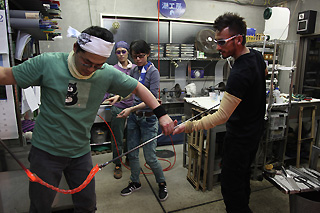
Nakata tried making a lace glass cup. First he made the glass rod that is the basic material. He combined molten glass rods in seven colors. Two people are needed to pull out the ends of two rods attached to a lump of glass.
Nakata held one rod and Konishi held the other. ”Let’s go,” said Konishi and the process began. Speed is a very important factor. ”Oh, it’s stretching!” Nakata was impressed at first, but his expression gradually grew grim. The glass became heavier as it stretched. By the time Nakata is told, ”Okay, you can put it down now, ” his arms were totally sore.
The glass rod shows a clear spiral pattern in seven colors, which made the hard work worth it.
The rod was then cut into small pieces to conform with the size of the final product. The small pieces were put together then molted, blown into the shape of a drinking cup. Small adjustments were repeated to make a cup with beautiful rainbow-colored lace.
The completed piece is delicate but the process was hard work. ”It was extremely hot,” mumbled Nakata. He experienced the difficulties and the enjoyment in glasswork, unique to Ushio Studio.
